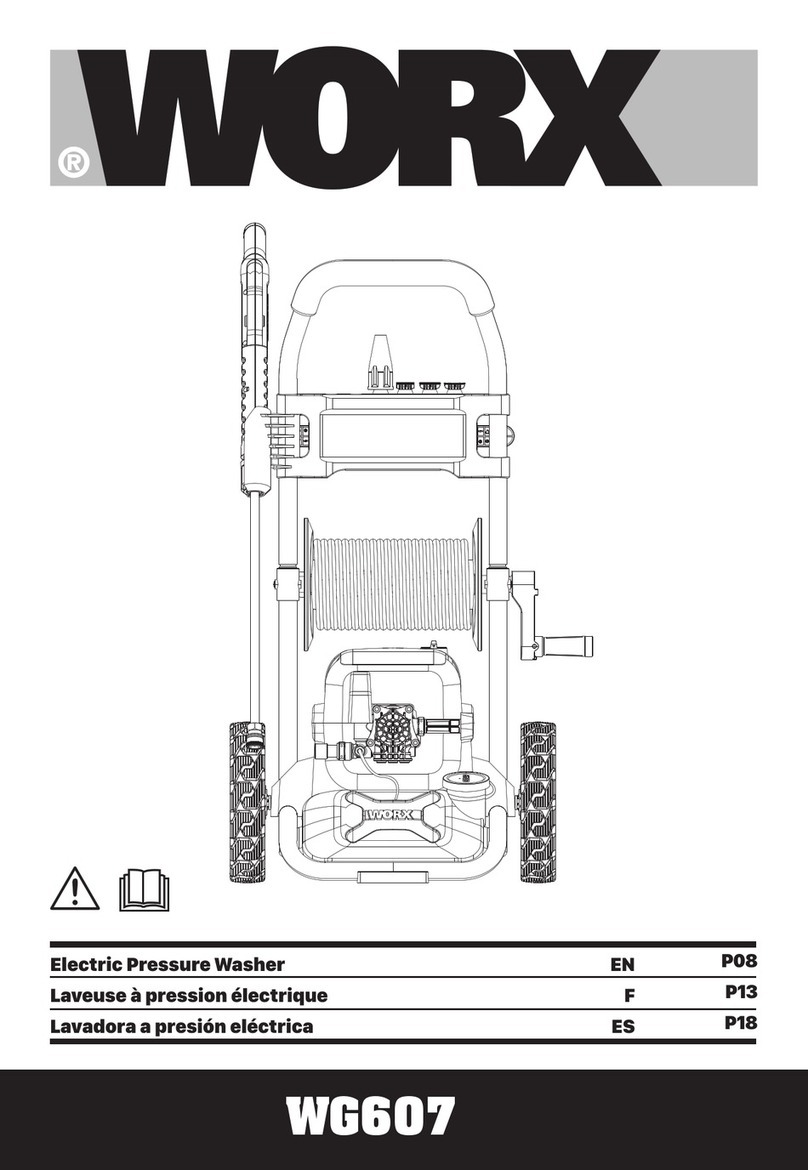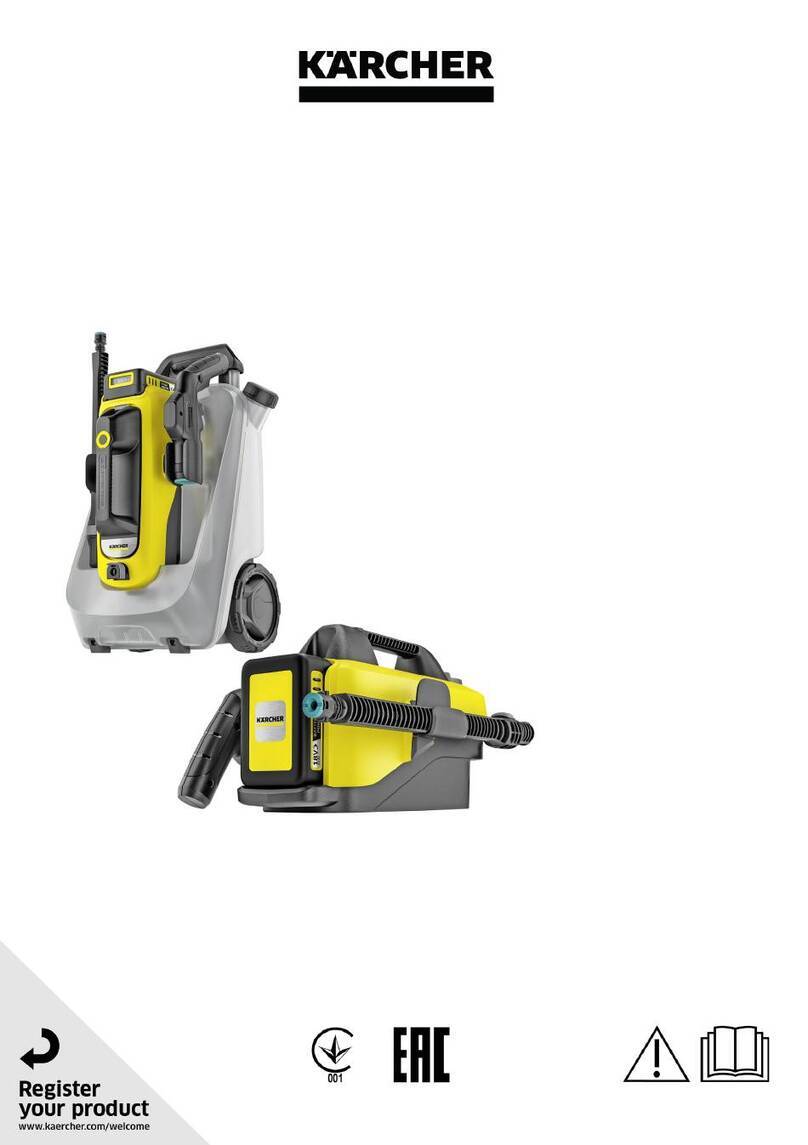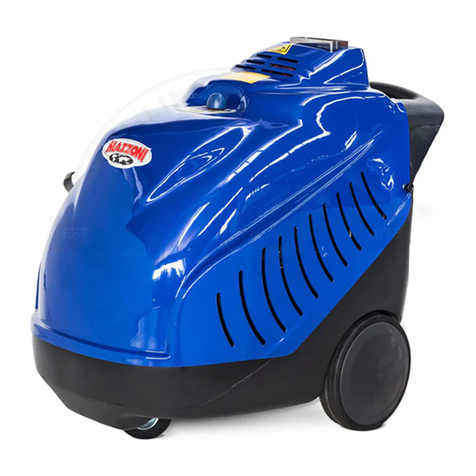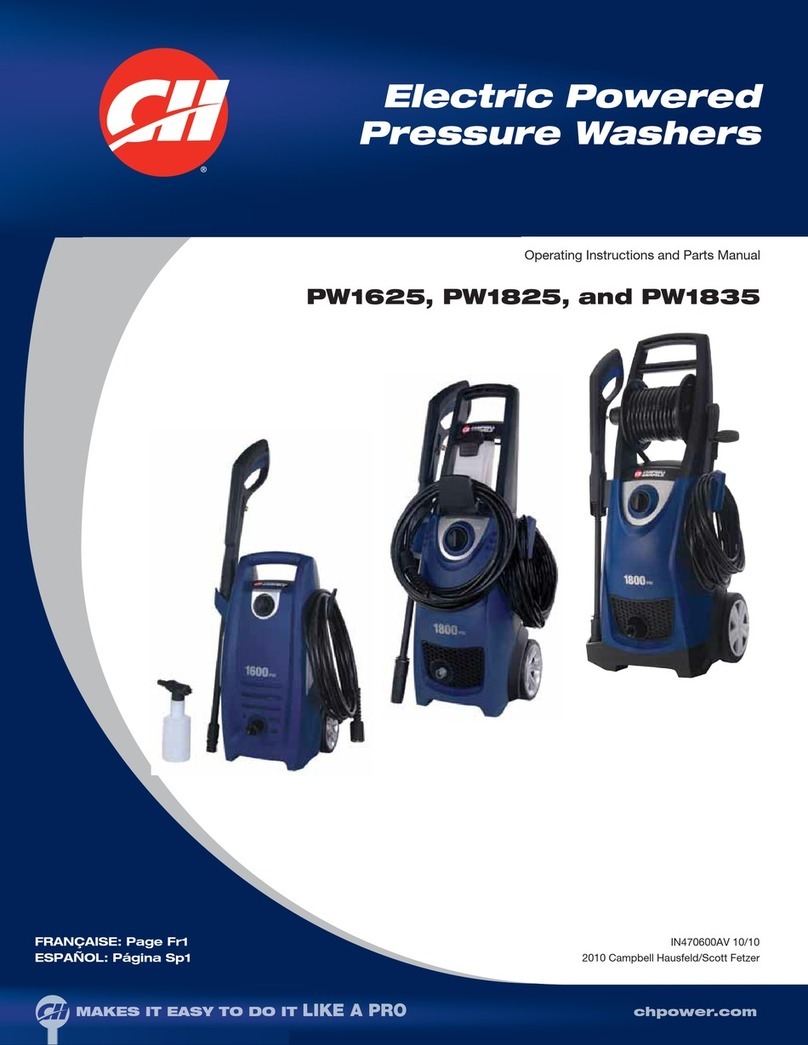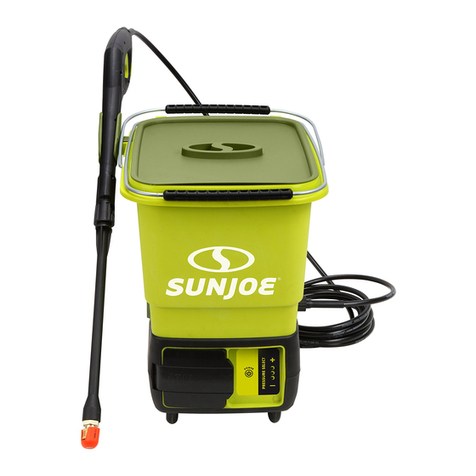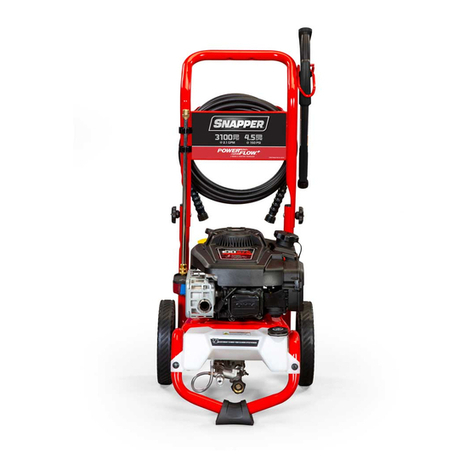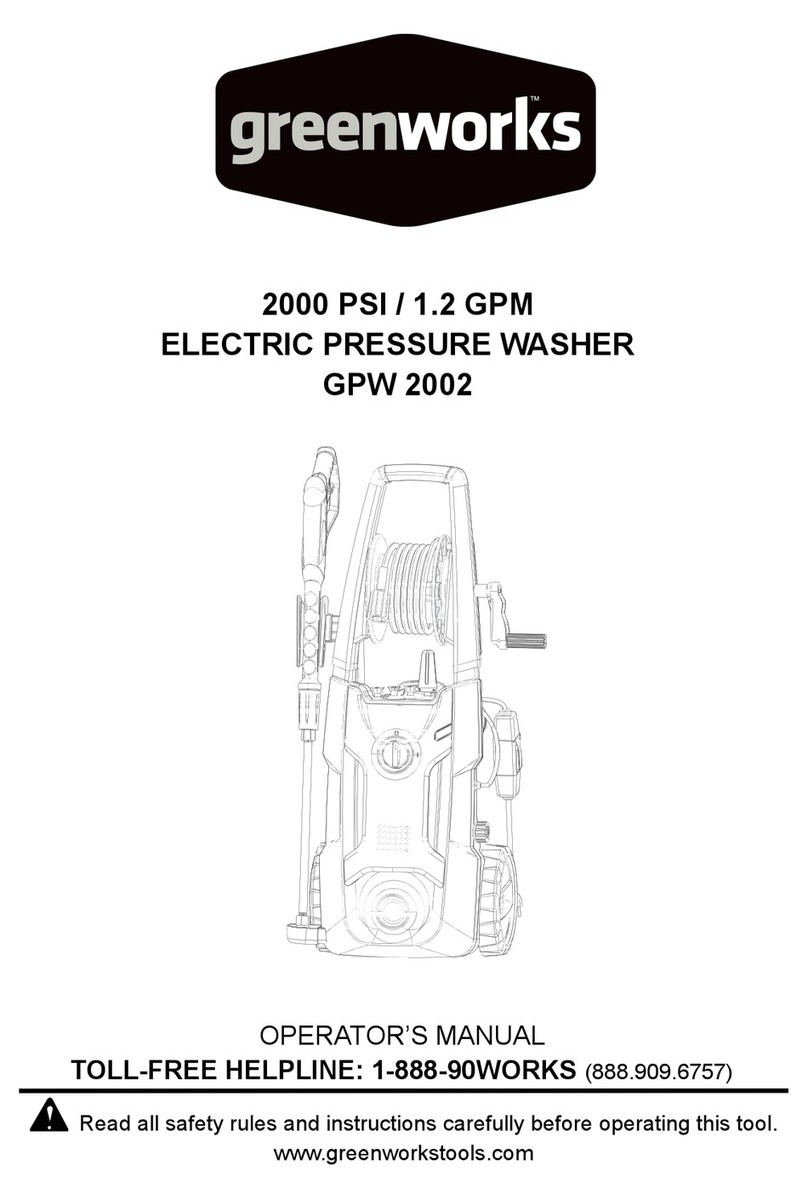MyTana MV80 User manual

MV80
MS80
050321
Manufacturers of Quality
Sewer & Drain Cleaning
Equipment since 1957
(800) 328-8170
Factory Direct Customer Service
M –F 7am – 5pm CST
Competent • Polite • Clear
www.MyTana.com
746 Selby Ave • St. Paul, MN 55104
fax: (651) 222-1739
User Guide for
MV80 and MS80 Jetters

PG 2
IMPORTANT NOTICE
FOR YOUR SAFETY, AND TO ENABLE MAXIMUM USE AND EFFECTIVENESS
OF YOUR EQUIPMENT, READ AND UNDERSTAND THIS INSTRUCTION MANUAL
ENTIRELY BEFORE USING YOUR HIGHPRESSURE WATER JETTING UNIT!
FAILURE TO FOLLOW INSTRUCTIONS AND REGULATIONS CONTAINED IN
THIS MANUAL CAN RESULT IN SERIOUS INJURY TO THE OPERATOR AND/OR TO
ANYONE IN CLOSE PROXIMITY TO THE WORK AREA.
The Jetting Process
Water Jetting—also know as sewer jetting or hydro-jetting—uses a combination of water pressure (psi)
and water ow (gpm) through a hose and nozzle to ush debris out of drain and/or sewer lines.
Water jetting is used to penetrate and wash out clogs or ice, potential blockages or to simply clean the
walls of drains and sewer lines to prevent future blockages.
uSewer jetting diers from normal pressure washing:
• Sewer jet nozzles direct the ow of water back toward the operator at a 20 to 45 degree angle. This backward
stream propels the sewer nozzle and accompanying hose forward into the sewer line and also cleans the walls
of the pipe.
• Jetting pumps deliver more ow and controlled pressure to clear tough blockages.
• Water pumps on sewer jetting equipment are modied to allow pulsation of water through the hose to the
nozzle. This pulsation creates a vibration or“wiggle”in the jetting hose that allows the hose to move through
a drain or sewer line with little resistance. Pulsating also reduces pressure and/or ow of the water, so most
pumps are equipped to turn pulsation on and o at will.
uComponents of water jet machines: Water pump; hose reel; various sub-components that protect the pump
and the operator; various nozzles for various cleaning applications and situations. Larger jetters use a water
storage tank for additional water supply.
MyTana stocks replacement parts for our jetters.
Many are available to purchase online at mytana.com/jetter-parts
MyTana MV80 | MS80 User Manual

PG 3
Pumps
• Remove“shipping” plug on top side of pumps and
replace with vented plug. This is very important
for the proper operation of the pumps.
• Do not store or run the pumps on its side or at a
sharp angle, since oil can run out of the vent plug.
Environment
• Use caution in conned, wet areas. Drain cleaning
professionals often work directly through non-trapped
openings into sewers — make sure that there is adequate
ventilation into the work area.
• Neutralize or remove corrosive drain cleaners from drain
before starting.
• Do not operate machine in areas where combustible
gases, liquids or dust are present. Fire or explosion may
occur.
Keep bystanders or unauthorized persons away
Insist they keep a safe distance before operating
high pressure equipment.
• Never hold on to nozzle or point it at anyone with
machine turned on. High pressure water streams can
cause serious bodily harm.
Always insert hose at least 3'- 4' into pipe opening and
hold onto hose before turning the machine on.
Shut the machine down:
• When changing nozzles, hose or reels.
• Before disconnecting water supply. Running a water
pump “dry” will seriously damage the water pump.
• If it will be unattended.
• If machine fails to run properly.
Common Sense Don’t operate equipment while smoking,
under the inuence of drugs, alcohol or if taking medica-
tion that alters alertness.
Keep all labels, decals, warnings, cautions, and instructions
with machine. For new decals or labels contact Mytana.
• NEVER spray ammable liquids or toxic chemicals (such
as insecticide or weed killer)
• NEVER run acids or hard caustics (such as lye) through the
pump. (Only water!)
• NEVER use chemicals or agents that are not compatible
with the Buna-N and PVC (polyvinyl chloride) or neoprene
covering of the hose.
• NEVER clean the machine using its own spray.
The machine is water-protected, but not water proof.
High-pressure spray could damage machine components.
Gas Jetters
• Operate machine in well ventilated environment.
Exhaust fumes can be potentially lethal to the
operator.
• DO NOT allow ame or sparks in the area of operation.
• DO NOT refuel engine when it is running or hot.
Spilled gasoline or gas vapor can ignite if it comes
in contact with hot engine.
• Be careful not to touch engine block or the manifold/
muer during operation. These areas will become
very hot during normal operation.
• DO NOT operate the machine with the air cleaner
cover removed, this can cause a re.
• DO NOT lay jetter unit on its side or tilt it backwards
more than 30° when transporting. This can cause gas
to leak out the cap vent.
uDO NOT ll the gas tank all the way. Leave
several inches of space between the gas and the
top of the tank to prevent gas from leaking out
when transporting.
Use of diesel fuel in the gas tank may damage the
engine. In case of fuel spill use a cloth to clean up the
spilled fuel and move the machine to another area
until all vapors have cleared.
Gas jetters that are ordered with an electric starter
package will have a battery attached. Batteries contain
sulfuric acid. Avoid direct skin contact. Wear protec-
tive gloves, clothing and eyewear when handling your
battery!
Maintenance
• Keep machine clean and dry to maximize perfor-
mance and longevity.
• Follow maintenance schedules such as changing oil,
check for weak spots, slices or cuts in hose, keep inlet
screen clean, replace nozzles when worn.
• Keep antifreeze in hose and pump in freezing
temperatures.
• Additional maintenance details follow in this manual.
Safety First! Instructions and Precautions
Vented
Plug
uRead Shut Down
instructions on pg 7.
MyTana MV80 | MS80 User Manual

PG 4
Additional Components
Water Inlet and Filter
Before attaching source hose to the jetter, run water
through the source hose to ush debris out of the faucet
and hose. Make sure the water is running clean and clear.
The water inlet has a lter to prevent small debris from
running through your pump. However recheck the inlet
lter before each use to make sure there is no obstruction.
Thermal Relief Valve
As stated earlier, water temperatures in excess of 145°
can damage the pump seals. The thermal relief valve will
release the hot water and allow cool water to enter pump
from fresh water supply. The valve also provides protection
when the pump goes into“bypass”meaning the pump is
running but no water is being pushed through the hose.
This happens automatically, and the valve will reset.
If the relief valves kicks in often, it most likely is failing,
and should be replaced, see MyTana.com/jetter-parts.
Hoses and Nozzles
Your jetter works via the proper blend of water pressure
and water volume: the more water that has to pass through
the restriction of a hose, the less pressure you will have at
the nozzle end.
To optimize cleaning power, use the shortest hose with the
largest inside diameter that you can. Pressure is lost as the
water travels down the length of the hose. As the length
increases, the pressure decreases. In addition, the smaller
the diameter of the hose, the greater of loss of pressure per
foot will be. The MS and MV80 jetters are optimized for 250’
of 3/8” hose.
The orices (holes) in the nozzle aect pressure. Over time,
water pressure will wear the orices in your nozzle resulting
in pressure drop and reduced cleaning eectiveness.
Nozzles need to be replaced as normal wear occurs.
When using new hose, run water through it to clean it out
before attaching the nozzle.
Pumps
Periodically change oil in pumps.
• Change oil after rst 30 hours of use for“break-in”
• After that, change every six months or at approximately
250 hours of use
• Recommended oil: General Pump (GP) Brand SAE 30W
Non-detergent
Do NOT run pump without water in it. This can damage
the cylinder walls, warp or crack the pump casing.
Do not use water more than 145°. This will damage seals.
Your pump is equipped with a thermal relief valve. However,
to optimize pump protection you should still avoid water (or
any pumped uid) that is too hot on the inlet side.
NEVER run pump if there is ice in pump or outlet hose.
See Care Tips section on page 7 for antifreeze procedure.
uIf the jetting unit will be unused for a period of time
(more than several days), even in warm temperatures,
we recommend running antifreeze through pump
and hose before storage. Antifreeze greatly reduces
the chance of rust, mineral deposits and other
contaminants damaging the pump during storage.
Clear lter
housing
Pressure
gauge
Unloader (pressure regulator)
Pulse-abler
control
Drain for
tank and
pump
MS / MV80 Components
MyTana MV80 | MS80 User Manual

PG 5
largest possible hose size in order to have as much pressure
as possible at the end of the hose.
Hoses of the same diameter may be coupled together
but it is not recommended for use in lines smaller than 8”
diameter. The solid metal of the combined hose connectors
and coupling, can get caught in bends in the line.
Pulse-abler
The stem and handle extending from one cylinder of
the water pump enables pulsation of the water stream
through the hose and nozzle.
By turning the pulse-abler handle clockwise (or right),
you temporarily disable one valve of the pump. This
creates pulsation or vibration in the hose, allowing the
hose to“wiggle”through tight bends quickly and easily.
Turn the pulse-abler control left to stop pulsation.
uUse pulsation only as needed to arrive at an
obstruction or to retrieve a stuck hose.
See more in Care Tips section, page 7.
Garden hose
hook-up
Throttle
Choke
Electric Start
Jumper
Hose
Ball valves
Pressure Regulator/Unloader
The regulator/unloader both regulates the pressure and
relieves pressure on the pump while in bypass.
The Regulator knob is located at the pump. It allows you to
adjust pressure during operation. Set the engine throttle
to a constant motor speed before adjusting pressure
regulator, lower rpm equals lower pressure at the pump,
while high rpm delivers higher pressure.
The Unloader prevents pressure overload in the event that
the nozzle is plugged or the ball valve is shut o. When
in the by-pass mode, the pump will continue to run.
uAvoid running in by-pass mode for more than
2 minutes if the by-pass is not returning to the
oat tank. It can damage the pump.
Pressure Gauge
The gauge reects pressure from the pump only, not
pressure at the end of the hose. It is important to select the
MyTana MV80 | MS80 User Manual

PG 6
Operation Instructions
1. Attach garden hose to water faucet. Check that ow
rate with your supply hose is at least 8 gal/minute.
Run water to clear air and ush debris out of faucet
and hose before connecting to pump.
Shut water o again when water runs clear.
2. Attach other end (male end) of garden hose to water
inlet valve at pump.
3. Connect jetter hose to reel.
4. Attach nozzle to end of hose. Finger tighten, do not
over tighten.
5. Mark the hose approximately 10ft back from nozzle
with electrical tape. Use this tape as your signal to shut
o machine before retrieving all the hose out of the
drain when you are nished.
6. Open water intake.
7. Open water faucet again
to prime pump. An equal
amount of water should
pass through the orices of
the nozzle.
8. Push jetter hose into drain
up to the marker if possible,
or minimally 3 to 4 feet.
9. Start Motor/Engine
• Turn the fuel valve to the“open”
position
• Pull out the choke lever.
Do not use choke if engine is warm
or ambient air temperature is high.
• Make sure the throttle is approxi-
mately halfway between “MIN” and “MAX”
• Turn key to “start” and start engine
• Push choke lever in
• Move throttle to desired speed
10. Adjust pressure with pressure regulator knob, turning
right to increase pressure, left to decrease.
uNOTE: For normal operation, do not exceed the
recommended 3000 psi with the 3/8”hose.
As the engine starts, the hose will start to advance down
the drain line. Pull the jet hose from the reel and guide it
into the line. After it advances a few feet, pull the hose back
1/2 way. The actual cleaning of the line takes place when
the hose is pulled back. Repeat the forward/back process.
Helpful Operating Hints
• Tight bends and certain blockages are often more
easily negotiated by rotating or twisting jetter hose at
drain opening. Form a loop of hose then rotate the loop
90° to 180° until the hose advances. If the hose still fails
to advance, switch to a smaller diameter hose
• Once you are through that area, pull back and pass
through several times to ensure cleaning.
• Any time you open a blockage(s), pull hose back very
slowly to provide maximum cleaning to wall of pipe.
• Use pulsation only if needed to promote forward motion
of nozzle and hose.
• When operating from the high end to low end (most
common) briey shut o the water ow ball valve on the
reel occasionally. This will allow debris to get ahead of the
nozzle and ush it down the pipe. It is best to clean the
line several times to ensure all debris is removed
• Grease and Ice Blockages High-pressure water can
be used to clear an ice blockage. A 3,000 PSI gas jet can
clear a 4”line at an approximate rate of one foot per
minute depending on the ice blockage. Ambient air
temperature will aect these times. Use a nozzle with a
forward jet. Warm water is eective in cleaning grease
and ice blockages as well. A cold-hot mix from the tap is
adequate. However, do not exceed 145° F, it can damage
seals in your pump.
Pre Operation Checklist
• Be sure you understand all
safety precautions (pg 3)
and have been trained to
use the machine.
• Locate jetter on level
surface where water won’t
pool, engage brake
• Check uid levels—
oil in pumps, oil and gas
in gas motor
• Check for adequate water
ow—supply hose should
deliver at least 8 gallons/
minute.
•
• Check hose for wear or
kinks, that all hoses
and lines are clear and that
inlet lter is clean
• Select nozzle and make
sure orices are not blocked
or worn to excess.
•
• Check that hose reel and all
connections are tight
• Wear protective clothing:
gloves, rubber boots and
goggles or face shield to
protect your eyes from
spray.
Remote Jetting Set Up
• Do steps 1-5
• Position the pressure hose
and reel at the drain site.
• Connect the 50’ jumper
hose between jetter and
the inlet on the hose reel.
• Open the ball valve
on the reel.
• Continue from step #6
MyTana MV80 | MS80 User Manual

PG 7
Shutting Down
1. When completing pass through drain, watch for tape
marker on hose as you pull the hose out.
2. Reduce pressure gradually with
pressure regulator knob until
pressure gauge is at zero.
3. Stop the jetter motor/engine
• Move throttle lever
down to MIN setting
(slowest setting)
• Turn the key to the
“o” position
• Turn the fuel valve to
the “o” position
4. Close water faucet and disconnect
garden hose from spigot.
5. Close ball valve. Disconnect garden hose
from jetter.
6. Pull remaining jetter hose from drain line.
7. Remove nozzle if you chose.
8. Store jetter hose properly on reel or in a coil to avoid
damage to hose.
Care Tips
Never let pump run dry!! Pump cavitation can occur in
only a few seconds of running dry.
Avoid running anything abrasive through pump Abrasive
materials will damage pump components, resulting in total
malfunction or, minimally, loss of pressure capability.
Keep jetter hose away from sharp edges and muer
• The hot muer can damage the coating on the hose
making it prone to bursting
• Sharp edges can scrape, slice and generally damage hose
quickly. While hose is easily replaced, it pays to take care
by buering sharp edges with tape, cardboard, etc., to
maximize its useful life. MyTana has a TigerTail that helps
protect your hose, see MyTana.com
Do not use Pulse-abler more than necessary This device
is what enables high-pressure cleaning through multiple
turns in sink and sewer lines. However, pulsing also creates
extreme vibration and faster wear on the pump. So, use
as needed, but do not use if a blockage or sewer line
conguration does not require it.
Anti Freeze Procedure If you know there will be a period
of several days when the jetter will be idle OR if the jetter
is stored in potentially freezing weather, make sure to run
antifreeze into pump and hose as part of your shut down
procedure. Simply insert a short length of garden hose into
a gallon of antifreeze, turn on pump an run until you see
antifreeze coming out of the nozzle end of the hose. At next
use of jetter, you can recover most of that antifreeze when
you hook up to your water source. Antifreeze can be used
multiple times. However if it gets to diluted (more than 50%
water) or if there is any discoloration, discard that antifreeze
and replace with new.
Maintenance
Regular inspection is the key to preventing breakdowns
and prolonging the life of the equipment. Follow this
maintenance schedule at the stated intervals to maximize
the life of your jetting equipment. SHUT OFF GAS ENGINE
BEFORE ATTEMPTING ANY REPAIRS OR MAINTENANCE.
Inspect and check for: Frequency
Leaks in discharge or inlet tting and hose Daily
Adequate water supply to the pump Daily
Jet nozzles are not clogged or worn Daily
Pump oil level, fuel level engine oil level Daily
PRESSURE HOSE for wear and damage. Weekly
INLET FILTER, and FUEL FILTER for dirt and
sediment.
Weekly
AIR CLEANER for dirt Weekly
Service item: Frequency
Pump Crankcase Oil Change* 1st mo. or 50 hrs.
then every yr. or 500 hrs.
Gear Reduction Oil Change** 1st mo. or 50 hrs.
then every yr. or 500 hrs.
Engine Oil Change*** 1st mo. or 20 hrs.
Every 6 mo. or 100 hrs.
Air Filter Cleaning 1st mo. or 50 hrs.
Every 3 mo. or 50 hrs.
Fuel Filter Change Every 6 mo. or 100 hrs.
Spark Plug Change Every 6 mo. or 100 hrs.
* Use SAE 30W Non-Detergent Motor Oil to full mark on dipstick
or to dot on sight glass.
** Use 90W Gear Oil. Fill to mark on dipstick or to dot on sight
glass for gear box.
*** Refer to engine manufacturer’s specications for correct oil
viscosity when adding engine oil.
Do not shut o
water ow with
ball valve until the
pressure is reduced
to zero. If the ball
valve on the reel
is shut o under
pressure, it can
create a pressure
lock and will be
hard to turn the
valve on for the
next job.
MyTana MV80 | MS80 User Manual

PG 8
Troubleshooting
!!Warning!! Before attempting any repairs or maintenance, make sure machine is shut o. For electric start units, disconnect
battery cables. Severe injury can occur due to electrical shock.
Problem CAUSE REPAIR
Pump Malfunction And Pressure Delivery Problems
Low Pressure
Worn or oversized nozzle Replace worn nozzle
Check nozzle size
Clogged water and/or chemical inlet strainer Clean or replace strainers
Worn or damaged plunger seals Replace plunger seals
Worn or damaged inlet or discharge valve Replace worn valve poppets or valve springs
Dirt or foreign particles in valve assembly Remove any dirt or particles
Air leak in inlet plumbing or discharge Locate air leak. Reseal connection or replace
damaged port
Rough operation with
loss of pressure
Restricted inlet plumbing, or air leak in inlet
plumbing
Repair clogged inlet ttings. Check supply hose
and ensure adequate water supply
Damaged plunger seal or pump valve Replace any damaged pump parts and clean
out any foreign particles
Clogged nozzles Clean or replace nozzles
Water leakage at intake
manifold or crankcase
Worn manifold seals, plungers, O-rings or
condensation inside crankcase
Replace seals, sleeves, or O-rings. Change oil at
regular interval
Inadequate water supply to pump creating a
vacuum lock
Ensure adequate tap water supply; clear inlet
lter
Oil leaks Worn pistons and/or leaking crank seals,
crankcase cover seal or drain plug seal
Replace seals, sleeves or O-rings
Excessive wear Worn and loose bearings Replace bearings. Check bearing seals, spacers,
and retainers. Replace any worn parts.
Short plunger seal
Abrasive particles in uid being pumped Replace water and chemical strainers if
damaged or missing. Install additional lter if
ne abrasives are still evident
Operator(s) running pump without water
supply
DO NOT ALLOW UNIT TO RUN WITHOUT
ADEQUATE WATER SUPPLY
Hot water in pump Do not run in bypass for more than 2 min. Do
not let water supply exceed 145° F
Irregular Spray pattern Worn or partially clogged nozzle Clean or replace nozzle
Unloader Valve Malfunction
Unloader cycles Fitting leaking downstream Tighten/replace tting
Clogged nozzle Clean or replace
Fluid leaking from body O-ring worn or cut Replace part as necessary
Unloader will not turn up
to pressure
Foreign particle in valve Replace or clean
Nozzle worn or sized incorrectly Replace part as necessary
Plunger or valve worn Replace part as necessary
Extreme pressure spikes Adjusting nut turned completely into unloader Loosen adjusting nut
Clogged nozzle Clean or replace
MyTana MV80 | MS80 User Manual
This manual suits for next models
1
Table of contents
Popular Pressure Washer manuals by other brands
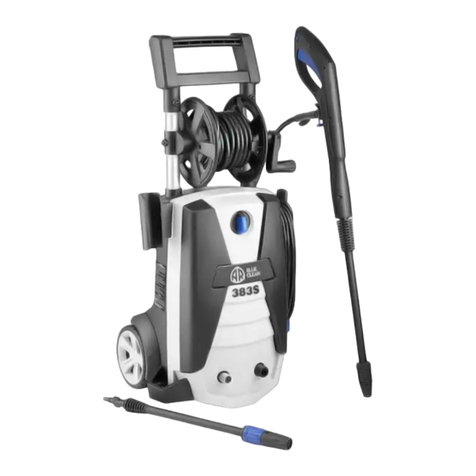
U-Line
U-Line H-6651 Troubleshooting

Homelite
Homelite HL252300 Replacement parts list
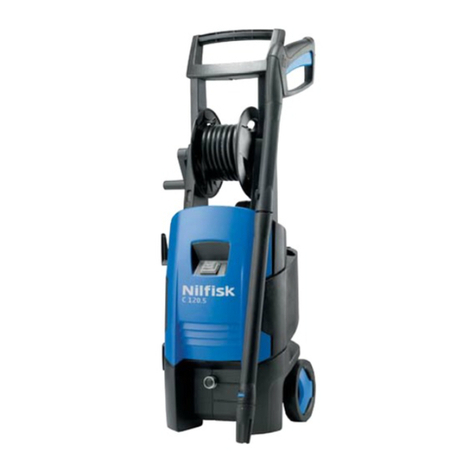
Nilfisk-Advance
Nilfisk-Advance Nilfisk C 120.3 quick start guide
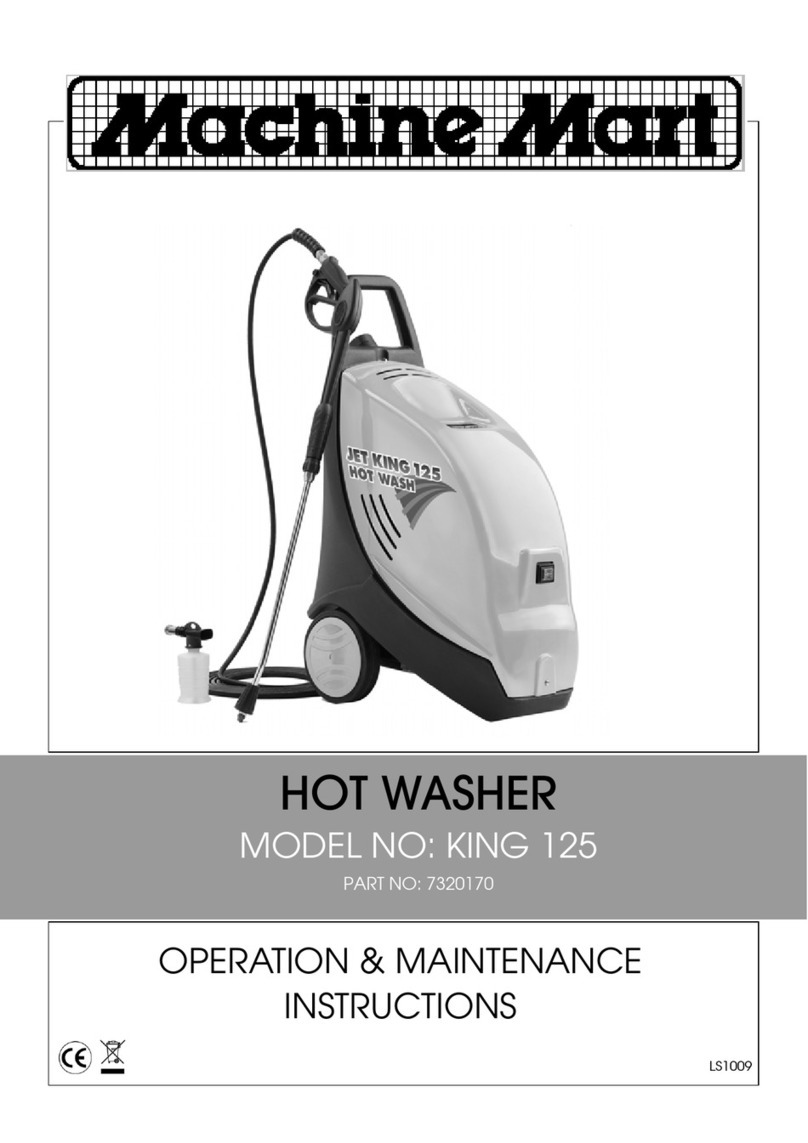
Machine Mart
Machine Mart KING 125 Operation & maintenance instructions

Kärcher
Kärcher 1.106-160.0 manual
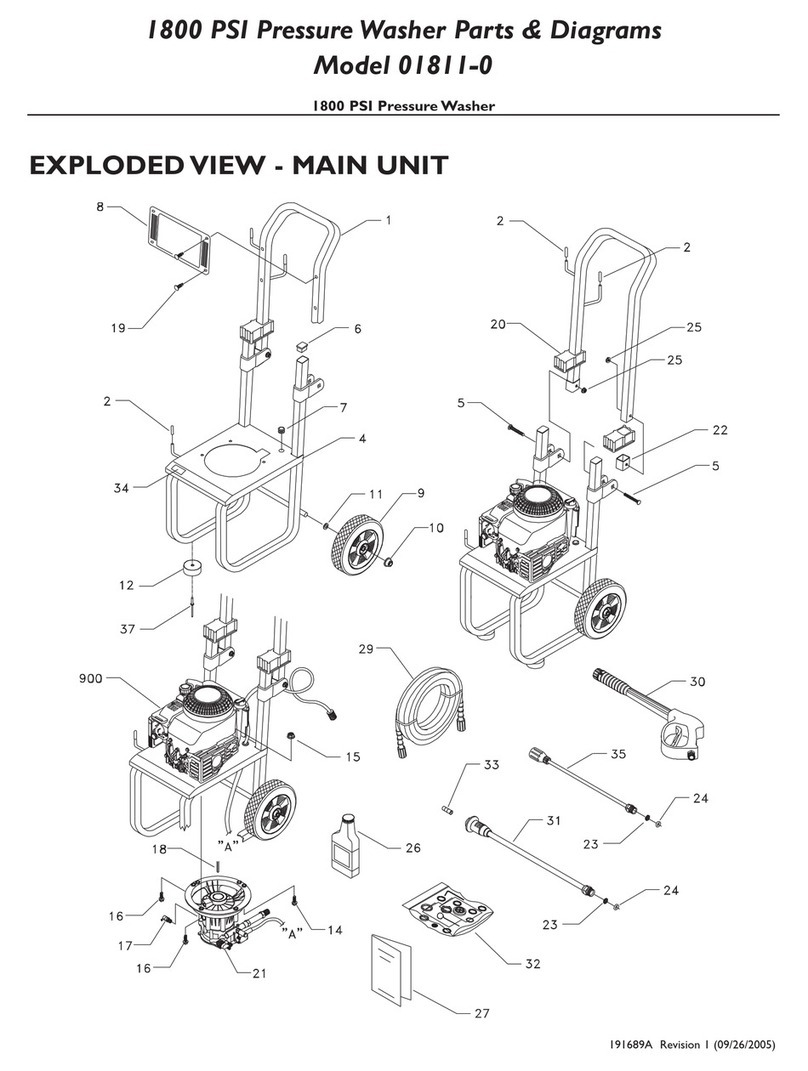
Briggs & Stratton
Briggs & Stratton 01811-0 Parts & Diagrams

